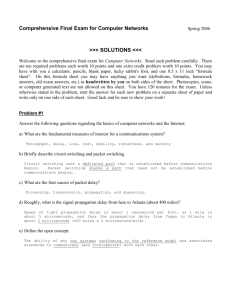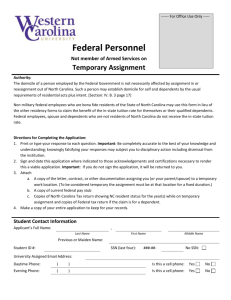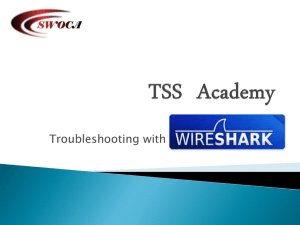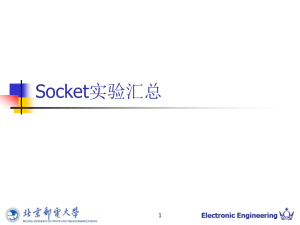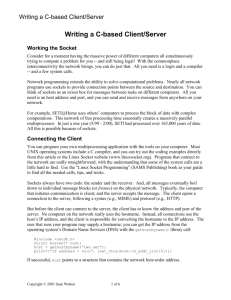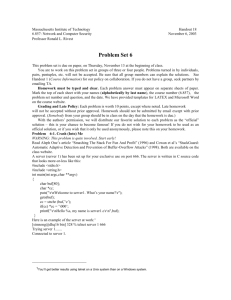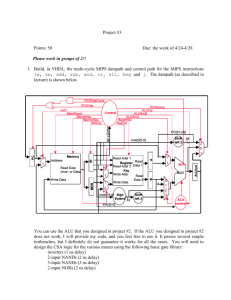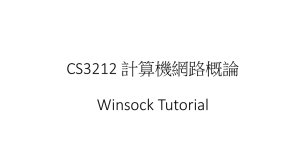Computer Networks Mid-Term Exam - Spring 2006
advertisement
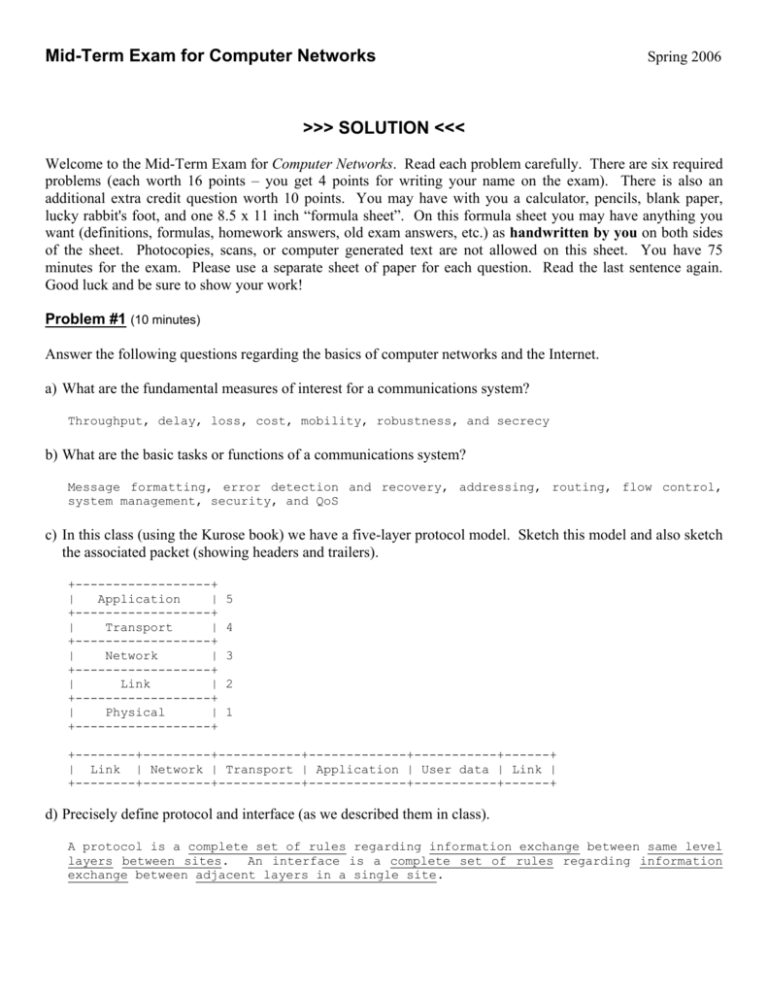
Mid-Term Exam for Computer Networks
Spring 2006
>>> SOLUTION <<<
Welcome to the Mid-Term Exam for Computer Networks. Read each problem carefully. There are six required
problems (each worth 16 points – you get 4 points for writing your name on the exam). There is also an
additional extra credit question worth 10 points. You may have with you a calculator, pencils, blank paper,
lucky rabbit's foot, and one 8.5 x 11 inch “formula sheet”. On this formula sheet you may have anything you
want (definitions, formulas, homework answers, old exam answers, etc.) as handwritten by you on both sides
of the sheet. Photocopies, scans, or computer generated text are not allowed on this sheet. You have 75
minutes for the exam. Please use a separate sheet of paper for each question. Read the last sentence again.
Good luck and be sure to show your work!
Problem #1 (10 minutes)
Answer the following questions regarding the basics of computer networks and the Internet.
a) What are the fundamental measures of interest for a communications system?
Throughput, delay, loss, cost, mobility, robustness, and secrecy
b) What are the basic tasks or functions of a communications system?
Message formatting, error detection and recovery, addressing, routing, flow control,
system management, security, and QoS
c) In this class (using the Kurose book) we have a five-layer protocol model. Sketch this model and also sketch
the associated packet (showing headers and trailers).
+------------------+
|
Application
|
+------------------+
|
Transport
|
+------------------+
|
Network
|
+------------------+
|
Link
|
+------------------+
|
Physical
|
+------------------+
5
4
3
2
1
+--------+---------+-----------+-------------+-----------+------+
| Link | Network | Transport | Application | User data | Link |
+--------+---------+-----------+-------------+-----------+------+
d) Precisely define protocol and interface (as we described them in class).
A protocol is a complete set of rules regarding information exchange between same level
layers between sites. An interface is a complete set of rules regarding information
exchange between adjacent layers in a single site.
Problem #2 (10 minutes)
Answer the following questions regarding the Internet.
a) What are the four causes of packet delay?
Processing, transmission, propagation, and queueuing.
b) What are the possible mechanisms of packet loss?
Buffer overflow (e.g., due to congestion) and electrical noise corrupting a packet
c) What is a tool that can be used to determine the number of hops to a destination and the round trip time
(RTT) for each hop?
traceroute
d) California is about 3000 miles from here. What is (approximately) the minimum possible RTT? Why would
the typical RTT be greater than this minimum? Show your work.
Propagation is about 1 nanosecond per foot, so about 5 microseconds per mile.
This
results in an about 30 ms minimum RTT. In reality, RTT would be greater due to having
to travel through multiple hops and thus also experience multiple transmission delays
and possible queueing delays.
e) What is quality of service?
QoS is the requirements an application places on the network.
Problem #3 (10 minutes)
Answer the following questions regarding the Application Layer.
a) What is HTTP (in about 100 words, use a drawing if it will help)?
The HyperText Transfer Protocol is a stateless application layer protocol.
HTTP is
used to transfer web content between a browser application (client) and an HTTP server.
All web content is identified by a URL. HTTP is a request response protocol that uses
TCP for assured delivery.
HTTP uses ASCII encoded headers.
The HTTP GET command
retrieves HTML files and other objects. The GET header includes the URL of the object
and other optional fields such as capability, language, and so on.
The response
includes a response header with a response code (code 200 is OK and 404 is page not
found). Other commands include POST and HEAD.
+--------+
+--------+
| Client |----- Request ------>| Server |
|
|<---- Response ------|
|
+--------+
+--------+
b) How is it that sender addresses can be spoofed in an email?
There is no authentication of commands in SMTP.
Thus anyone with access to an SMTP
server can enter any from address (i.e., spoof who they are).
c) We say that FTP has out-of-band control. What do we mean by that?
We mean that commands and data flow across different TCP connections.
Problem #4 (10 minutes)
Answer the following question regarding sockets programming:
Attached are server.c and client.c with some “bugs”. Identify the bugs and explain how to fix them.
Server program:
• Missing welcome_s = socket() after line 25
• Missing htons() in line 28
• Missing bind() after line 29
• Listen must have more than 0 connections in line 31
• Missing addr_len assignment after line 32
• Missing +1 for strlen for \0 in line 38
• Should recv() on connect_s in line 38
• Should send() on connect_s in line 38
• Missing closesocket() of welcome_s after line 42
Client program:
• Type of server_addr should be struct sickaddr_in in line 18
• Size of out_buf and in_buf is too small in lines 19 and 20
• Should be SOCK_STREAM and not DATAGRAM in line 24
• Missing htons() in line 28
• Missing +1 for strlen for \0 in line 36
Problem #5 (15 minutes)
Answer the following questions regarding reliable data transfer and its performance:
a) Give a trace (a packet timing diagram) of the operation of RDT 3.0 when data packets and acknowledgement
packets are garbled (corrupted). Suppose the protocol has been in operation for some time. The RDT 3.0
sender and RDT 2.2 receiver FSMs are attached at the end of this exam.
Sender sends M0
M0 corrupted
A1
Sender ignores A1
Timeout: sender
resends M0
M0
Packet garbled, receiver
resends last ACK (A1)
Corrupted
data
A0
M1
A1
sender sends M0
M0
sender sends M1
A0
M1
Ignore ACK
Timeout: sender
resends M1
A1 corrupted
M1
A1
M0
Corrupted
ACK
We can suppose that the sender is
in state “Wait for call from
above” (top left hand corner) and
the receiver is in state “Wait
for 0 from below”. The scenarios
for corrupted data and corrupted
ACK are shown in the following
figure
b) Assume that you have a 1000 mile long 1 Mb/s link. For a packet length of 1500 bytes, what is the link
utilization if stop-and-wait protocol is used? What if sliding window protocol is used with a window size of
10? You may assume that the sender always has packets to send and that no packets are lost or corrupted.
1000 miles is about 5 milliseconds propagation (for 1 nanosecond per foot). The packet
transmission time is 12 milliseconds. So, U_saw = (12 / (12 + 2x5)) = 54.5%. If the
window size is 10, then clearly the utilization will be 100% because (10x12) > 12 +
2x5.
Problem #6 (15 minutes)
Answer the following questions regarding TCP, UDP, IP, and routing:
a) What are the important fields in the TCP, UDP, and IP headers? Without these fields, the protocols would
clearly not “work”.
TCP = ports #s, seq/ack #s, flags, checksum, and windows size
UDP = port #s and checksum
IP = addresses, checksum for header
b) Sketch the TCP connection initiation and connection termination packet flows using a timing diagram.
Client
Server
|
|
|----- SYN ---->|
|
|
|<--- SYN-ACK --|
|
|
|------ ACK --->|
|
|
|
|
|----- FIN ---->|
|
|
|<---- ACK -----|
|
|
|<---- FIN -----|
|
|
|------ ACK --->|
|
|
c) What are the important attributes for a good routing algorithm?
Fast, simple, little traffic, no loops, converge to optimum
d) What is a key difference between a distance vector and link state routing protocol?
DV uses neighbor
information.
exchange
of
routing
vectors,
LS
uses
broadcast
of
link
state
e) For the following five node network topology with link costs as shown, find the shortest path from node A to
all other nodes using Dijkstra’s algorithm. Clearly describe the order of links as they as added one-by-one by
the algorithm and give the path costs.
1
A ------|
|
|
|5
|
|
|
2
E -------
3
B ------- D
|
/
|
/
|
/
|1
/ 1
|
/
|
/
| /
C /
Order of edges added and cost of new path added
AB at cost 1
AB, BC at cost 2
AB, BC, CD at cost 3
AB, BC, CD, CE at cost 4
Extra Credit (5 minutes)
Consider 5 users (call them A, B, C, D, and E) that have connections on a single 10 Mb/s link. Connections last
for several minutes or perhaps even hours (i.e., they are bounded in time). Assume that user A requests 2 Mb/s
for its connection, B requests 1 Mb/s, C requests 3 Mb/s, D requests 4 Mb/s, and E request 10 Mb/s. Note that
the total requested bandwidth (20 Mb/s) exceeds the link bandwidth (10 Mb/s). Describe at least three ways of
fairly allocating the 10 Mb/s to the five users. Carefully discuss/describe what is “fair”. Carefully discuss the
trade-offs between your different definitions of “fair”. Multiple definitions of fair are possible.
One definition of fair can be to allocate resource proportional to need.
A
B
C
D
E
So,
gets (2/20)(10) Mb/s = 1.0 Mb/s
gets (1/20)(10)
= 0.5
gets (3/20)(10)
= 1.5
gets (4/20)(10)
= 2.0
get (10/20)(10)
= 5.0
This definition of fairness rewards over-requesting (cheating) to get a larger share
against other users. We note that in this example, no user is 100% happy (i.e., has
the full allocation that it requested).
Max-min allocation is another definition of fairness.
So,
All get 2 Mb/s in a first round with A satisfied, B satisfied and with 1 Mb/s to give
back, C, D, and E all with bandwidth still needed.
The 1 Mb/s is then allocated
between C, D, and E (each get 1/3 Mb/s) such that in the end we have
A
B
C
D
E
gets
gets
gets
gets
gets
2 Mb/s
1 Mb/s
2.33 Mb/s
2.33 Mb/s
2.33 Mb/s
This definition of fairness does not reward cheating (asking for more than you need)
and does also allow some users to be 100% happy. This definition of fairness, however,
does not fully consider need (i.e., the user requesting the most does not necessarily
get the most).
Finally, a random allocation of the entire link to a user can be long term fair, but
inefficient (and not short term fair either). So, first give A all its wants. When A
is done, give B all it wants, and so on. This method also does not reward cheating
since a connection simply uses all it needs and requesting an excess has no benefit.
1.
2.
3.
4.
//======================================================= file = server.c =====
//= A message "server" program to demonstrate sockets programming
=
//=
- TCP/IP client/server model is implemented
=
//=============================================================================
5.
6.
7.
8.
//----- Include files --------------------------------------------------------#include <stdio.h>
// Needed for printf()
#include <string.h>
// Needed for memcpy() and strcpy()
#include <windows.h>
// Needed for all Winsock stuff
9.
10.
//----- Defines --------------------------------------------------------------#define PORT_NUM
1050
// Arbitrary port number for the server
11.
12.
13.
14.
15.
16.
17.
18.
19.
20.
21.
22.
23.
//===== Main program ==========================================================
void main(void)
{
WORD wVersionRequested = MAKEWORD(1,1);
// Stuff for WSA functions
WSADATA wsaData;
// Stuff for WSA functions
unsigned int
welcome_s;
// Welcome socket descriptor
struct sockaddr_in
server_addr;
// Server Internet address
unsigned int
connect_s;
// Connection socket descriptor
struct sockaddr_in
client_addr;
// Client Internet address
struct in_addr
client_ip_addr; // Client IP address
int
addr_len;
// Internet address length
char
out_buf[100];
// Output buffer for data
char
in_buf[100];
// Input buffer for data
24.
25.
// This stuff initializes winsock
WSAStartup(wVersionRequested, &wsaData);
26.
27.
28.
29.
// Fill-in server (my) address information and bind the welcome socket
server_addr.sin_family = AF_INET;
server_addr.sin_port = PORT_NUM;
server_addr.sin_addr.s_addr = htonl(INADDR_ANY);
30.
31.
// Listen on welcome socket for a connection
listen(welcome_s, 0);
32.
33.
// Accept a connection.
connect_s = accept(welcome_s, (struct sockaddr *)&client_addr, &addr_len);
34.
35.
// Print an informational message that accept completed
printf("Accept completed \n”);
36.
37.
38.
// Send to the client using the connect socket
strcpy(out_buf, "Test message from server to client");
send(welcome_s, out_buf, strlen(out_buf), 0);
39.
40.
41.
// Receive from the client using the connect socket
recv(welcome_s, in_buf, sizeof(in_buf), 0);
printf("Received from client... data = '%s' \n", in_buf);
42.
43.
44.
45.
// Close sockets and clean-up
closesocket(connect_s);
WSACleanup();
}
1.
2.
3.
4.
//======================================================= file = client.c =====
//= A message "client" program to demonstrate sockets programming
=
//=
- TCP/IP client/server model is implemented
=
//=============================================================================
5.
6.
7.
8.
//----- Include files --------------------------------------------------------#include <stdio.h>
// Needed for printf()
#include <string.h>
// Needed for memcpy() and strcpy()
#include <windows.h>
// Needed for all Winsock stuff
9.
10.
11.
//----- Defines --------------------------------------------------------------#define PORT_NUM
1050
// Port number used at the server
#define IP_ADDR
"127.0.0.1" // IP address of server (*** HARDWIRED ***)
12.
13.
14.
15.
16.
17.
18.
19.
20.
//===== Main program ==========================================================
void main(void)
{
WORD wVersionRequested = MAKEWORD(1,1);
// Stuff for WSA functions
WSADATA wsaData;
// Stuff for WSA functions
unsigned int
client_s;
// Client socket descriptor
double
server_addr;
// Server Internet address
char
out_buf[10];
// Output buffer for data
char
in_buf[10];
// Input buffer for data
21.
22.
// This stuff initializes winsock
WSAStartup(wVersionRequested, &wsaData);
23.
24.
// Create a client socket
client_s = socket(AF_INET, DATAGRAM, 0);
25.
26.
27.
28.
29.
30.
// Fill-in the server's address information and do a connect with the
// listening server
server_addr.sin_family = AF_INET;
server_addr.sin_port = PORT_NUM;
server_addr.sin_addr.s_addr = inet_addr(IP_ADDR);
connect(client_s, (struct sockaddr *)&server_addr, sizeof(server_addr));
31.
32.
33.
// Receive from the server using the client socket
recv(client_s, in_buf, sizeof(in_buf), 0);
printf("Received from server... data = '%s' \n", in_buf);
34.
35.
36.
// Send to the server using the client socket
strcpy(out_buf, "Test message from client to server");
send(client_s, out_buf, strlen(out_buf), 0);
37.
38.
39.
40.
// Close and clean-up
closesocket(client_s);
WSACleanup();
}
FSMs for RDT 3.0 server and RDT 2.2 receiver from Kurose
